Papers by Dr. Devendra Dusane
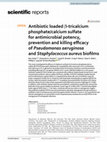
Scientific Reports
This study investigated the efficacy of a biphasic synthetic β-tricalcium phosphate/calcium sulfa... more This study investigated the efficacy of a biphasic synthetic β-tricalcium phosphate/calcium sulfate (β-TCP/CS) bone graft substitute for compatibility with vancomycin (V) in combination with tobramycin (T) or gentamicin (G) evidenced by the duration of potency and the prevention and killing efficacies of P. aeruginosa (PAO1) and S. aureus (SAP231) biofilms in in vitro assays. Antibiotic loaded β-TCP/CS beads were compared with antibiotic loaded beads formed from a well characterized synthetic calcium sulfate (CS) bone void filler. β-TCP/CS antibiotic loaded showed antimicrobial potency against PAO1 in a repeated Kirby-Bauer like zone of inhibition assay for 6 days compared to 8 days for CS. However, both bead types showed potency against SAP231 for 40 days. Both formulations loaded with V + T completely prevented biofilm formation (CFU below detection limits) for the 3 days of the experiment with daily fresh inoculum challenges (P
Advances in Experimental Medicine and Biology

Antimicrobial Agents and Chemotherapy
Pseudomonas aeruginosa is an opportunistic bacterial pathogen and is known to produce biofilms. W... more Pseudomonas aeruginosa is an opportunistic bacterial pathogen and is known to produce biofilms. We previously showed the emergence of colony variants in the presence of tobramycin-loaded calcium sulfate beads. In this study, we characterized the variant colonies, which survived the antibiotic treatment, and identified three distinct phenotypes—classically resistant colonies, viable but nonculturable colonies (VBNC), and phoenix colonies. Phoenix colonies, described here for the first time, grow out of the zone of clearance of antibiotic-loaded beads from lawn biofilms while there are still very high concentrations of antibiotic present, suggesting an antibiotic-resistant phenotype. However, upon subculturing of these isolates, phoenix colonies return to wild-type levels of antibiotic susceptibility. Compared with the wild type, phoenix colonies are morphologically similar aside from a deficiency in green pigmentation. Phoenix colonies do not recapitulate the phenotype of any previou...
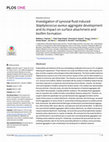
PLOS ONE
Periprosthetic joint infections (PJIs) are a devastating complication that occurs in 2% of patien... more Periprosthetic joint infections (PJIs) are a devastating complication that occurs in 2% of patients following joint replacement. These infections are costly and difficult to treat, often requiring multiple corrective surgeries and prolonged antimicrobial treatments. The Gram-positive bacterium Staphylococcus aureus is one of the most common causes of PJIs, and it is often resistant to a number of commonly used antimicrobials. This tolerance can be partially attributed to the ability of S. aureus to form biofilms. Biofilms associated with the surface of indwelling medical devices have been observed on components removed during chronic infection, however, the development and localization of biofilms during PJIs remains unclear. Prior studies have demonstrated that synovial fluid, in the joint cavity, promotes the development of bacterial aggregates with many biofilm-like properties, including antibiotic resistance. We anticipate these aggregates have an important role in biofilm formation and antibiotic tolerance during PJIs. Therefore, we sought to determine specifically how synovial fluid promotes aggregate formation and the impact of this process on surface attachment. Using flow cytometry and microscopy, we quantified the aggregation of various clinical S. aureus strains following exposure to purified synovial fluid components. We determined that fibrinogen and fibronectin promoted bacterial aggregation, while cell free DNA, serum albumin, and hyaluronic acid had minimal effect. To determine how synovial fluid mediated aggregation affects surface attachment, we utilized microscopy to measure bacterial attachment. Surprisingly, we found that synovial fluid significantly impeded bacterial surface attachment to a variety of materials. We conclude from this study that fibrinogen and fibronectin in synovial fluid have a crucial role in promoting bacterial aggregation and inhibiting surface adhesion during PJI. Collectively, we propose that synovial fluid may have conflicting protective roles for the host by preventing adhesion to surfaces, but by promoting bacterial aggregation is also contributing to the development of antibiotic tolerance.
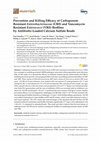
Materials
Carbapenem-resistant Enterobacteriaceae (CRE) and vancomycin-resistant Enterococci (VRE) have eme... more Carbapenem-resistant Enterobacteriaceae (CRE) and vancomycin-resistant Enterococci (VRE) have emerged as multidrug-resistant (MDR) pathogens associated with periprosthetic joint infections (PJI). In this study, we evaluated the efficacy of antibiotic-loaded calcium sulfate beads (ALCSB) in inhibiting bacterial growth, encouraging biofilm formation and killing preformed biofilms of CRE and VRE. Three strains of Klebsiella pneumoniae (KP) and a strain of Enterococcus faecalis (EF) were used. ALCSB of 4.8-mm diameter were loaded with vancomycin (V) and gentamicin (G), V and rifampicin (R), V and tobramycin (T) or R and meropenem (M), and placed onto tryptic soy agar (TSA), spread with one of the test strains and incubated for 24 h at 37 °C. Beads were transferred daily onto fresh TSA spread plates and the zone of inhibition (ZOI) was recorded until no inhibition was observed. ALCSB containing R + M or R + V produced the most extensive ZOI up to 5 weeks. Biofilm prevention efficacy was ...
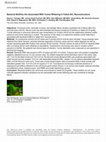
Orthopaedic Journal of Sports Medicine
Objectives: Technical errors, traumatic re-injury, and biologic failure all play a potential role... more Objectives: Technical errors, traumatic re-injury, and biologic failure all play a potential role in failure after ACL reconstruction (ACLR). Recent work has demonstrated the frequent presence of biofilms on failed ACLR grafts. Tunnel widening is commonly observed upon presentation for revision ACLR but the relationship between biofilm presence and tunnel widening is unclear. The purpose of this study is to determine whether tunnel widening is associated with bacterial biofilms in failed ACL reconstructions. Methods: 34 consecutive revision ACLR cases and 5 primary ACLR controls were included. Tissue biopsies were obtained from tibial, femoral, and intra-articular segments of revision cases and torn native ligament as well as excess hamstring graft after fixation from primary ACLR controls. Clinical cultures as well as PCR for bacterial DNA with a universal primer were obtained on all patients. Fluorescence microscopy was used to visually confirm presence of biofilm. No patients had...
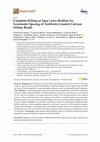
Materials
Background: Pseudomonas aeruginosa (PA) and Staphylococcus aureus (SA) are the major causative ag... more Background: Pseudomonas aeruginosa (PA) and Staphylococcus aureus (SA) are the major causative agents of acute and chronic infections. Antibiotic-loaded calcium sulfate beads (ALCSB) are used in the management of musculoskeletal infections such as periprosthetic joint infections (PJI). Methods: To determine whether the number and spatial distribution of ALCSB are important factors to totally eradicate biofilms, ALCSBs containing vancomycin and tobramycin were placed on 24 h agar lawn biofilms as a single bead in the center, or as 16 beads placed as four clusters of four, a ring around the edge and as a group in the center or 19 beads evenly across the plate. Bioluminescence was used to assess spatial metabolic activity in real time. Replica plating was used to assess viability. Results: For both strains antibiotics released from the beads completely killed biofilm bacteria in a zone immediately adjacent to each bead. However, for PA extended incubation revealed the emergence of resi...
Knee Surgery, Sports Traumatology, Arthroscopy
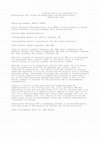
Arthroscopy: The Journal of Arthroscopic & Related Surgery
Purpose: To determine whether bacterial DNA will be detectable via polymerase chain reaction (PCR... more Purpose: To determine whether bacterial DNA will be detectable via polymerase chain reaction (PCR) in torn graft tissue at time of revision anterior cruciate ligament reconstruction (ACLR). Methods: A total of 31 consecutive revision ACLR cases from one center were recruited from 2014-2016. No patients had clinical signs of infection on presentation. Torn graft tissue was obtained in revision cases and subjected to clinical culture and PCR analysis with a universal bacterial primer. Fluorescent microscopy was utilized to confirm presence of a biofilm. Negative controls samples were obtained of water open to air on the field and excess primary ACLR graft tissue as well as torn native ligament to evaluate for PCR positivity due to environmental contamination. Results: Clinical cultures were positive (coagulase negative staphylococcus) in one revision case (3%, 1/31). Bacterial DNA was detectable in most revision ACLR cases 27/31 (87.0%) and there was a low rate of PCR positivity in negative control samples of water open to air (0%, 0/3), excess primary ACLR graft tissue after passage (20%, 1/5) or native torn ligament (20%, 1/5). Bacterial biofilm presence on failed graft tissue as well as monofilament suture was visually confirmed with fluorescent microscopy. Conclusions: Bacterial DNA is frequently present in failed ACLR grafts, with high rates of DNA detection by PCR but low culture positivity.
Clinical Orthopaedics and Related Research®

Journal of controlled release : official journal of the Controlled Release Society, Jan 28, 2017
Antibiotic loaded cement beads are commonly used for the treatment of biofilm related orthopaedic... more Antibiotic loaded cement beads are commonly used for the treatment of biofilm related orthopaedic periprosthetic infections; however the effects of antibiotic loading and exposure of beads to body fluids on release kinetics are unclear. The purpose of this study was to determine the effects of (i) antibiotic loading density (ii) loading amount (iii) material type and (iv) exposure to body fluids (blood or synovial fluid) on release kinetics and efficacy of antibiotics against planktonic and lawn biofilm bacteria. Short-term release into an agar gel was evaluated using a fluorescent tracer (fluorescein) incorporated in the carrier materials calcium sulfate (CaSO4) and poly methyl methacrylate (PMMA). Different fluorescein concentrations in CaSO4 beads were evaluated. Mechanical properties of fluorescein-incorporated beads were analyzed. Efficacy of the antibiotics vancomycin (VAN) or tobramycin (TOB) alone and in combination was evaluated against lawn biofilms of bioluminescent strai...
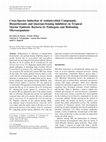
Current Microbiology, Mar 1, 2011
Enhancement or induction of antimicrobial, biosurfactant, and quorum-sensing inhibition property ... more Enhancement or induction of antimicrobial, biosurfactant, and quorum-sensing inhibition property in marine bacteria due to cross-species and cross-genera interactions was investigated. Four marine epibiotic bacteria (Bacillus sp. S3, B. pumilus S8, B. licheniformis D1, and Serratia marcescens V1) displaying antimicrobial activity against pathogenic or biofouling fungi (Candida albicans CA and Yarrowia lipolytica YL), and bacteria (Pseudomonas aeruginosa PA and Bacillus pumilus BP) were chosen for this study. The marine epibiotic bacteria when co-cultivated with the aforementioned fungi or bacteria showed induction or enhancement in antimicrobial activity, biosurfactant production, and quorum-sensing inhibition. Antifungal activity against Y. lipolytica YL was induced by co-cultivation of the pathogens or biofouling strains with the marine Bacillus sp. S3, B. pumilus S8, or B. licheniformis D1. Antibacterial activity against Ps. aeruginosa PA or B. pumilus BP was enhanced in most of the marine isolates after co-cultivation. Biosurfactant activity was significantly increased when cells of B. pumilus BP were co-cultivated with S. marcescens V1, B. pumilus S8, or B. licheniformis D1. Pigment reduction in the quorum-sensing inhibition indicator strain Chromobacterium violaceum 12472 was evident when the marine strain of Bacillus sp. S3 was grown in the presence of the inducer strain Ps. aeruginosa PA, suggesting quorum-sensing inhibition. The study has important ecological and biotechnological implications in terms of microbial competition in natural environments and enhancement of secondary metabolite production.
Biofouling, 2011
This article may be used for research, teaching, and private study purposes. Any substantial or s... more This article may be used for research, teaching, and private study purposes. Any substantial or systematic reproduction, redistribution, reselling, loan, sub-licensing, systematic supply, or distribution in any form to anyone is expressly forbidden. The publisher does not give any warranty express or implied or make any representation that the contents will be complete or accurate or up to date. The accuracy of any instructions, formulae, and drug doses should be independently verified with primary sources. The publisher shall not be liable for any loss, actions, claims, proceedings, demand, or costs or damages whatsoever or howsoever caused arising directly or indirectly in connection with or arising out of the use of this material.
Scientific Reports
Electrochemically generated bactericidal compounds have been shown to eradicate bacterial lawn bi... more Electrochemically generated bactericidal compounds have been shown to eradicate bacterial lawn biofilms through electroceutical treatment. However, the ultrastructure of biofilms exposed to these species has not been studied. Moreover, it is unknown if the efficacy of electroceutical treatment extends to antibiotic-resistant variants that emerge in lawn biofilms after antibiotic treatment. In this report, the efficacy of the in vitro electroceutical treatment of Pseudomonas aeruginosa biofilms is demonstrated both at room temperature and in an incubator, with a ~4 log decrease (p
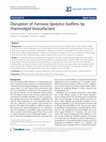
Background: Yarrowia lipolytica is an ascomycetous dimorphic fungus that exhibits biofilm mode of... more Background: Yarrowia lipolytica is an ascomycetous dimorphic fungus that exhibits biofilm mode of growth. Earlier work has shown that biosurfactants such as rhamnolipids are efficient dispersants of bacterial biofilms. However, their effectiveness against fungal biofilms (particularly Y. lipolytica) has not been investigated. The aim of this study was to determine the effect of rhamnolipid on a biofilm forming strain of Y. lipolytica. Two chemical surfactants, cetyl-trimethyl ammonium bromide (CTAB) and sodium dodecyl sulphate (SDS) were used as controls for comparison. Results: The methylene blue dye exclusion assay indicated an increase in fungal cell permeability after rhamnolipid treatment. Microtiter plate assay showed that the surfactant coating decreased Y. lipolytica biofilm formation by 50%. Rhamnolipid treatment disrupted pre-formed biofilms in a more effective manner than the other two surfactants. Confocal laser scanning microscopic studies showed that biofilm formation onto glass surfaces was decreased by 67% after sub-minimum inhibitory concentration (sub-MIC) treatment with rhamnolipids. The disruption of biofilms after rhamnolipid treatment was significant (P<0.05) when compared to SDS and CTAB.
http://blogs.nature.com/indigenus/2014/02/away-from-home-why-the-postdoc-phase-is-crucial.html

Canadian Journal of Microbiology, 2015
Chromobacterium violaceum is an opportunistic pathogen that causes infections that are difficult ... more Chromobacterium violaceum is an opportunistic pathogen that causes infections that are difficult to treat. The goal of this research was to evaluate the effect of selected tannins (tannic acid (TA) and gallic acid (GA)) on bacterial growth, motility, antibiotic (carbenicillin, tetracycline) susceptibility, and biofilm formation. Both tannins, particularly TA, impaired bacterial growth levels and swimming motilities at sub-minimum inhibitory concentrations (sub-MICs). In combination with tannins, antibiotics showed increased MICs, suggesting that tannins interfered with antibacterial activity. Sub-MICs of tetracycline or TA alone enhanced biofilm formation of C. violaceum; however, in combination, these compounds inhibited biofilm formation. In contrast, carbenicillin at sub-MICs was effective in inhibiting C. violaceum biofilm formation; however, in combination with lower concentrations of TA or GA, biofilms were enhanced. These results provide insights into the effects of tannins on C. violaceum growth and their varying interaction with antibiotics used to target C. violaceum infections.



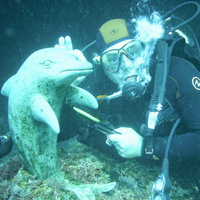



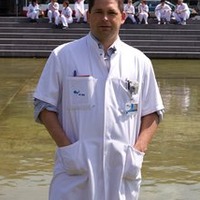
Uploads
Papers by Dr. Devendra Dusane